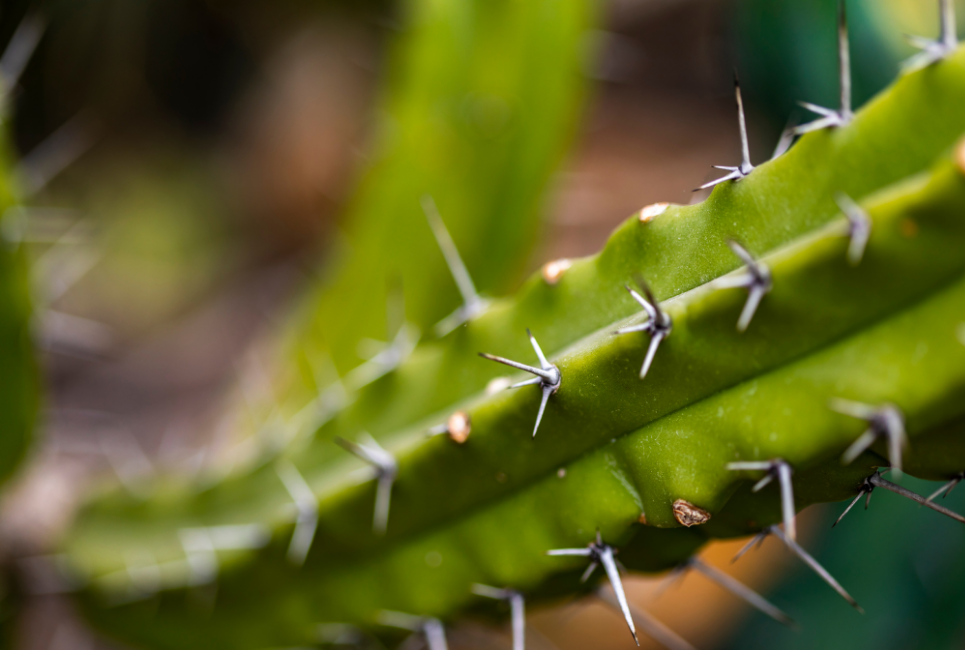This is the quintessential cactus. When you think of popular western films or the nineteenth-century Santa Fe Trail wagon trains, you probably picture this type of cactus lingering in the background. But this cactus is not just about by-gone days and nostalgic pop culture, it is also a wonderful plant to keep at home or in a garden.
How to Identify Blueberry Cactus
Blueberry Cactus has a few distinct features that help to identify it. These features are:
- Its stems grow in a way that resembles a candelabra
- Its stems have between 5 to 8 ribs that are covered with areoles
- Its stems have areoles that contain 3 to 5 spines that are poky but not extremely dangerous
- It grows between 13 to 16 feet tall
- It grows in a sprawling shrub-like formation
- It produces a small berry that resembles a blueberry (the berries are dark purple, sweet, and edible)
Where Does Blueberry Cactus Grow
This cactus is native to the northern and central regions of Mexico.
Uses of Blueberry Cactus
More than just a decorative plant, Blueberry Cactus is often used for its aroma and its ability to be a food product.
How to Grow Blueberry Cactus from Seed
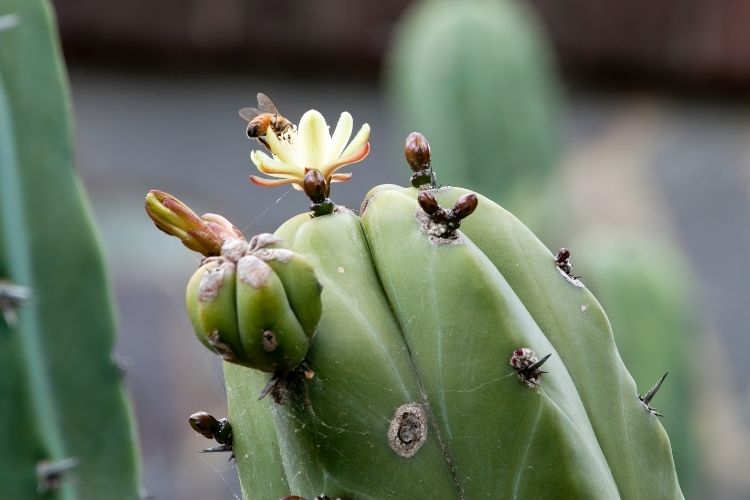
Growing a Blueberry Cactus from seed is a relatively simple process. Just follow these steps:
- Gather the necessary supplies before planting the seeds. You will need, seeds, a seed tray, and succulent soil.
- Clean your hands and workspace before touching the seeds
- Fill the seed tray with the succulent soil
- Place the seeds on top of the soil
- Place the seed tray lid or plastic wrap over the top of the seeds to keep the humidity level high
- Place the seed tray in a spot that is warm and shaded from sunlight
- Once sprouts are visible, they can be watered regularly
- Remove the lid of the seed tray to encourage airflow
Blueberry Cactus Growing Conditions
Blueberry Cactus has the typical needs of any succulent or cactus: plenty of heat and sunlight, well-draining soil, and infrequent watering.
When to Plant Blueberry Cactus
It is recommended that Blueberry Cactus is planted during the warm, sunny months of spring and summer.
How to Plant Blueberry Cactus
When planting a Blueberry Cactus, it is a good idea to keep these tips in mind.
- Use a container that has drainage holes or select a ground plot that will drain water
- Use potting soil that is well-draining
- Use gravel at the bottom of the container or ground plot for extra drainage (optional)
- Since this succulent is not cold hardy, it is best to check the USDA Hardiness Zones Map before placing a Blueberry Cactus in a ground plot
Once you have selected where to plant your Blueberry Cactus and the proper potting soil, follow these steps to plant it:
- Place some gravel at the bottom of the container or the ground plot selected
- Place the potting soil on top of the gravel
- Make a small hole in the potting soil
- Set the plant into the hole
- Cover the roots with potting soil and make sure the plant is secure in its new home
- Water the plant until the soil is moist but not soggy
Blueberry Cactus Water Requirements
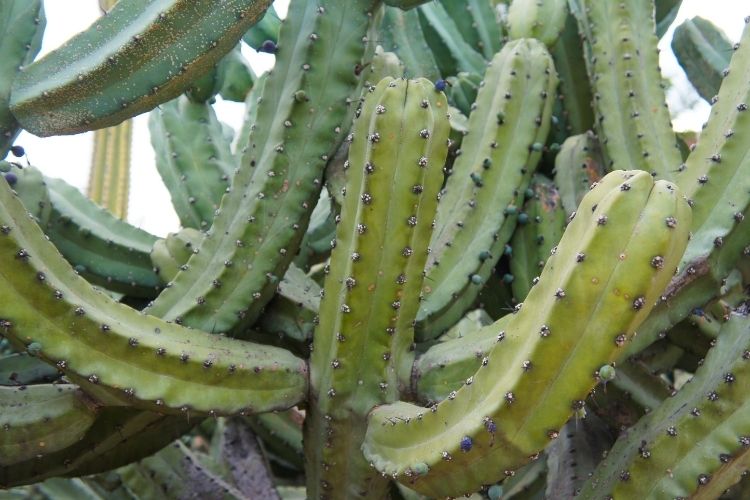
Blueberry Cactus requires very little and very infrequent watering. Since this plant is susceptible to root rot, it is best to allow them to dry out completely between watering sessions. The best way to water a potted Blueberry Cactus is to use the soak and dry method. The steps for doing this are as follows:
- Fill a tray or a sink with a few inches of water.
- Set the plant container in the tray making sure that the water is not so deep that it will run over the top of the container. The point of watering in this way is so that the roots will soak up the water and the leaves will not get wet.
- Let the plant soak in the water for fifteen minutes. This will allow the root system to soak up water from the bottom of the container.
- Take the plant container out of the water.
- Place the plant container in a spot where the excess water can drain from the hole in the bottom.
- Repeat this only when the soil around the plant is dry.
Blueberry Cactus Sun Requirements
This plant is not tolerant of cold or rainy weather so it cannot be placed in the ground outside if temperatures in the area typically dip below 50 degrees Fahrenheit or there are frequent rainy seasons.
When considering where to plant or place this plant’s container, find a spot that will get between six to eight hours of bright, direct sunlight each day. Also, make sure that its planter or ground plot will be able to drain off the excess water well.
Best Blueberry Cactus Fertilizer
Too much fertilizer will cause a bigger problem for Blueberry Cactus than too little fertilizer will. However, it can be given a dose of 5-10-5 fertilizer once a month during its growing season (spring and summer).
Never fertilize a Blueberry Cactus during winter because it is dormant at that time and the fertilizer will harm the plant.
Best Blueberry Cactus Companion Plantings
Don’ let your Blueberry Cactus go through life alone: provide it with a fun companion plant. Even though it is a prickly plant, it does need a friend or two, so try one of these options.
Fairy Castle Cactus
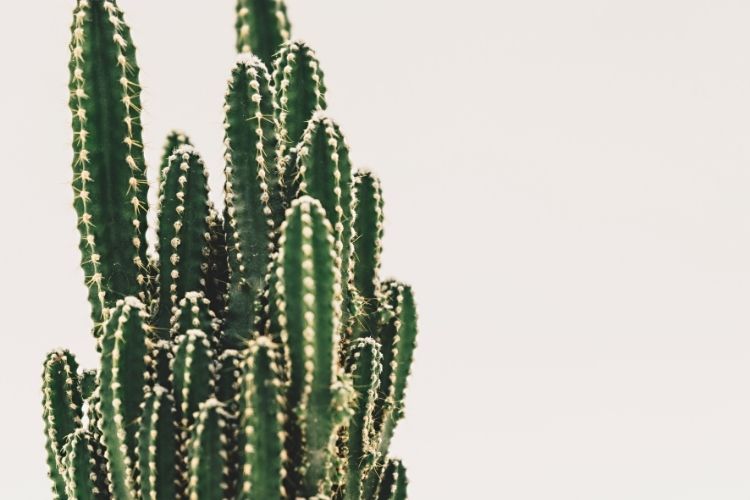
Fairy Castle Cactus is a hassle-free and beginner-friendly cactus that adds an enchanting feel to garden spaces. It will be the perfect companion plant for a Blueberry Cactus.
Pros
- Grows indoors very well
- Drought tolerant
- Prefers lots of direct sunlight
- Does not need a lot of water
- Does not need a lot of fertilizer
Cons
- Slightly toxic
- Can grow up to 6 feet tall
- Susceptible to mealybugs, mites, and gnats
- Does not tolerate cold weather
- Texas Prickly-pear
Texas Prickly-pear
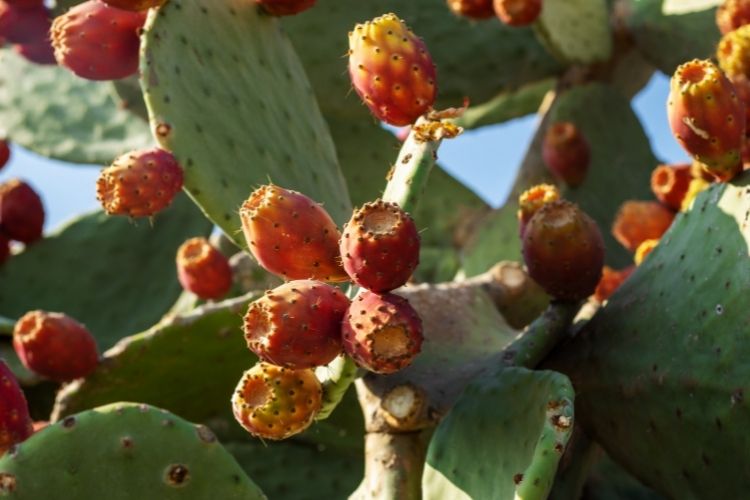
Texas Prickly-pear is another one of the most recognizable types of cactus and deserves a spot next to your Blueberry Cactus. Another plus is that it is also incredibly easy to care for. Set one of these next to your Blueberry Cactus and you will be well on your way to creating your own Western film set.
Pros
- Drought tolerant
- Does not need a lot of water
- It is easy to propagate from stem cuttings and seeds
- It is generally not toxic
Cons
- Can grow up to 8 feet wide and 5 feet tall
- Does not tolerate cold weather (should only be grown in the ground in USDA hardiness zone 8)
- Does not grow indoors very well
Dinosaur Back Plant
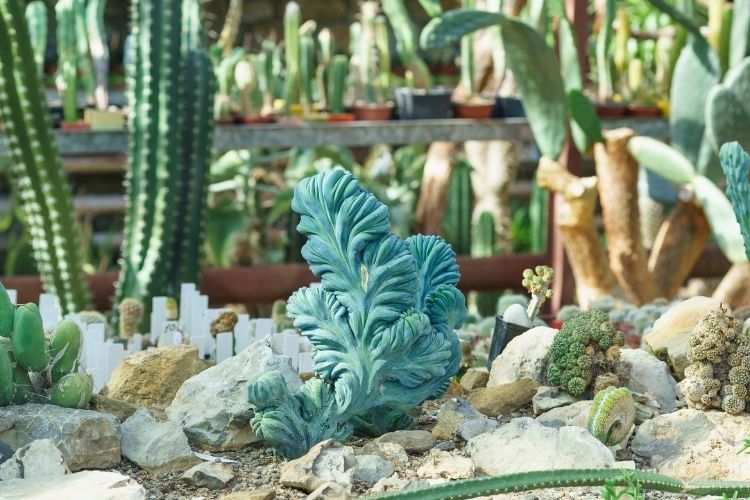
If ever there was a plant that looked like it stepped out of the Jurassic era, this is it. The stems are stumpy and wavy with a hint of a dinosaur shape. It is truly a unique and wonderful plant. Just picture it next to your Blueberry Cactus and how delightful your natural scenery would be on a sci-fi movie set.
Pros
- Drought tolerant
- Does not need a lot of water
- It is not toxic
- It can be propagated by stem cuttings and leaves
Cons
- Does not grow indoors very well
- Can grow up to 2 feet wide and 6 feet tall
- It is not cold hardy
Blueberry Cactus Diseases and Common Problems
The most common issues faced by Blueberry Cactus are root rot and overgrowth.
Blueberry Cactus Treatments and Maintenance
Root Rot
Dealing with root rot is a very difficult process that doesn’t guarantee success, so it is always best to prevent it from even occurring. To prevent root rot, take the time to learn how to properly water a succulent. But, if it has already begun, follow these steps to help the plant survive:
Allow the plant to dry out: This technique can be done if the root rot has not spread to the stems. What it entails is taking the plant out of the soil and letting them layout for a few days so the excess water will evaporate. Once this has been done, they should be replanted in fresh, clean, and dry soil.
Remove any of the rotten parts of the plant: Trim off any areas of the plant that are rotting, then allow the plant to callous for a few days. Without letting it callous, the chances of the succulent surviving are very slim.
Add some sulfur: This technique should be done after the plant has been trimmed of all its rotted areas and allowed to callous. It will require that you dust a little sulfur on its root system to help prevent the spread of microbes.
Behead the plant: This is the last resort technique, but if this is the method that you feel is necessary for your rotting plant, this video can help you through the process.
Dealing with root rot is a very difficult process that doesn’t guarantee success, so it is always best to prevent it from even occurring. To prevent root rot, take the time to learn how to properly water a succulent.
Overgrowth
This cactus may start growing slowly but once it gets going, it will take over a plot of dirt. In fact, it is such a spirited grower that it can even cause itself damage by crowding its stems so that they do not have access to proper amounts of dirt and sunlight.
The best way to treat a cactus that is overgrowing its container or ground plot is to replant part of it elsewhere.
Blueberry Cactus Repotting Instructions

When it comes time to replant a Blueberry Cactus, keep these tips in mind:
- Plant it in an area that will get 6 to 8 hours of direct sunlight
- Plant it in well-draining soil (succulent/cacti potting mix)
- Plant it in the ground only if you live in a region that is within USDA Hardiness Zones 9a to 11b; otherwise, it will need to be kept in a container that can be transported indoors during cold or rainy weather
- Use a sterile cutting utensil to remove a stem for propagation
- Always let the cut stem callous before replanting it
Where to Buy Blueberry Cactus Seeds Online
This type of cactus is commonly propagated via seed because the seeds are so easy to harvest from a mature and blooming cactus. If you don’t currently have access to a cactus that is producing seeds, consider purchasing seeds from one of these online shops:
Where to Buy Blueberry Cactus Plants Online
If you want to skip the seed stage and get straight into enjoy a Blueberry Cactus plant in your garden or home, consider purchasing a plant from one of these online shops:
FAQs
Question: Are All Cacti Succulents?
Answer: Cacti are a subgroup of succulents, so all cacti are succulents, but of course, not all succulents are cacti.
Question: What Are the Differences Between Cacti and Succulents?
Answer:
– Cacti usually do not have many leaves, or any at all; whereas, succulents usually do.
– Cacti grow with areoles. These are the bumps that produce the spines or needles that make cacti so treacherous to touch.
– Nearly all types of cacti are native to the Americas; whereas, non-cactus succulents are native to many different regions worldwide.
Question: Is Blueberry Cactus Toxic?
Answer: No, these are not toxic; in fact, the berries they produce are often eaten.
Question: Will Blueberry Cactus Turn Colors When Put Under Healthy Stressors?
Answer: No, unfortunately, this type of cactus will remain green or green-gray no matter how much heat and sunlight it is exposed to.
Question: Is Blueberry Cactus Related to Candelabra Cactus?
Answer: Yes, these two types of cacti are in the same genus, Myrtillocatus. Other members of the genus are Myrtillocatus Eichlamii and Myrtillocatus Schenckii.
Question: What is Cactus Corking?
Answer: This is a natural process that cacti, including Blueberry Cactus, can go through. It is a browning of the cactus that some viewers think looks like fungus, a disease, or a dying stem. However, this is part of the aging process of cacti.
If you are wondering why your cactus is turning a shade of brown, it could be going through the process of corking. Here are some of the features of cactus corking to help you decide if this is why your cactus is brown, or if there could be another reason.
Traits of Corking:
– Begins at the bottom of the stem
– Usually grows up the stem evenly without patches
– Slowly grows; this does not happen quickly or overnight
– The cactus stem should still feel firm or hard, not squishy when touched
Concluding Thoughts
The addition of a Blueberry Cactus in a home or garden is certainly a wonderful thing. It provides beauty and awe of nature.
This is also one of those plants that inspire nostalgia and artistic expression at the same time. Don’t miss out on owning this undemanding and undeniably fabulous plant.
Research Citations
For more plant-related articles, read our guides below:
- Cotyledon Orbiculata (Pig’s Ear): All You Need To Know
- Cephalocereus Senilis (Old Man Cactus) How To Grow and Care 101
- Gymnocalycium Mihanovichii (Moon Cactus): Easy Care Tips
- Lophocereus Marginatus (Mexican Fence Post Cactus) - January 10, 2022
- Best Cactus Fertilizer Guide - January 9, 2022
- Selenicereus Grandiflorus (Queen of the Night) - January 3, 2022

